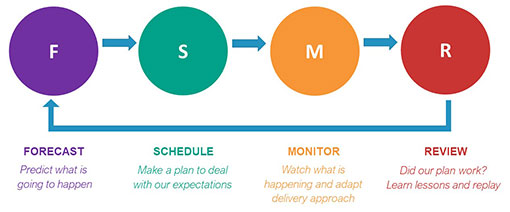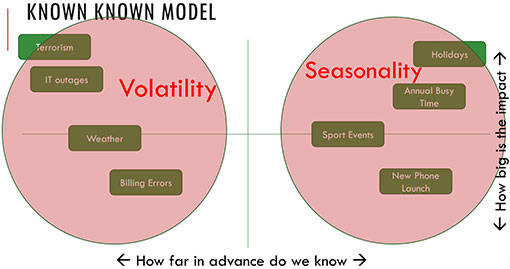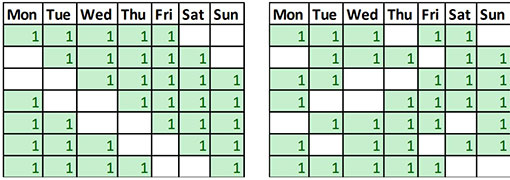We explore the fundamentals of shift planning, giving lots of expert tips along the way for how to get more from your contact centre schedules.
The Basics of Shift Planning

Justin Robbins
As Justin Robbins of 8×8 once said: “A good contact centre report will always show the impact on the business, the customer and the employee.”
From this, we can ascertain that while, of course, it is great to generate money, if we are working advisors to the bone and only considering the immediate financial impact, we are going to have sickness and attrition problems down the line.
But why is this point so key when thinking about shift planning?
Well, according to John Casey of CCplanning, “To have the most effective schedule possible, we’re going to have look at the business, customer and staff impact. If we push this triangle too far in any of these directions, something’s going to fall.”
Don’t Lose the Balance
For many, the main focus of a scheduler is service level, and there is no doubt that one of their key jobs is maximizing SLAs, but sometimes we have to ask ourselves: what is the cost of that?
There is no doubt that one of their key jobs is maximizing SLAs, but sometimes we have to ask ourselves: what is the cost of that?
Is that extra percentage point or two worth employee dissatisfaction, as well as increased absence and attrition? Because if these rates start to go in the wrong direction, what does that do to our business results in the long run?
So, sometimes we should take a step back and ask ourselves how we can balance business, customer and employee needs, so we’re actively paying attention to each of these fundamentals.
Don’t Forget to Measure as You Go
While we can pay attention to our three fundamental areas, it’s important that we know how good a job we are doing in each. We need to have the right measures.
But first, we need to take a close look at our capacity plans and determine how we define schedule efficiency and then set a measure off the back of that thinking.
“We must always have a tracker attached to our schedules, to see what we are actually delivering against the staffing requirements that we need, in retrospect,” John adds.
For our advice on tracking schedule efficiency as a metric, read our article: How to Calculate Schedule Efficiency
Where Does Shift Planning Fit Into Our Resource-Planning Cycle?
The planning cycle, as shown below, is something that we should not forget, as it’s important to consider where scheduling sits, since we are so reliant on the results that we get from forecasting.

We discuss the planning cycle in more depth in the article: Resource Planning: What You Need to Know
However, we also need to be conscious of the fact that if we neglect the scheduling phase, the real-time monitoring team are affected by what we do.
So it’s well worth saying that a schedule is only as good as what we are given, but if we don’t do it to the best of our abilities, we will be causing more problems for our colleagues down the line.
While scheduling can go wrong immediately through poor forecasting, even with high forecast accuracy, we can get shift planning wrong by failing to understand the randomness of human behaviour.
For some key pieces of advice, covering the four areas of the resource planning cycle, read our article: Workforce Planning: 20 Fundamental Rules
Is It Time to Say Goodbye to Traditional Full-Time Shifts?
We need to think about what goes on in the day-to-day lives of our customers to cause peaks in contact volumes, before considering how we balance that.
When thinking about this, we will likely find that, depending on our opening hours, offering just full-time shifts is no longer valid.
To help make this point, here’s an example of a typical contact centre call-arrival pattern, plotting contact volumes against times of the day.

On this chart we can see the classic “M” shape, which many contact centres will recognize as being typical of their call arrivals too.
But when we put two sets of full-time shifts against this pattern, as denoted by the orange line, we experience the age-old problem of having too many staff taking calls in the middle of the day.
While this is great in ensuring that everybody gets a good lunch break, as well as for running extra training and focus groups, those activities will never meet the demand. There is always going to be too much green between the blue bars and the orange line in this example.
Also, while we have a surplus of advisors in the middle of the day, there are points at the beginning and end of the day where we are short-staffed.
Then, add in that randomness of human behaviour factor and how random events will impact our plans. What happens at the end of the day if there is a sudden influx of contacts, or in the middle of the day if it’s even quieter than expected?
Planning Is About Random Events
Random events can be caused by customers and staff. So we need to think about what unexpected things both of these groups can do to impact our schedules and when.
When considering this, we also need to be careful that we are not shoehorning our staff into a one-size-fits-all shift pattern. While rotational shift patterns and different fixed-shift patterns may be equal in our eyes, that perception might not be the same for other members of the contact centre team.
Each advisor’s perception of the perfect shift, what is fair and what is going to help them stick to the business, is different from the person’s beside them.
“Each advisor’s perception of the perfect shift, what is fair and what is going to help them stick to the business, is different from the person’s beside them,” adds John.
With this in mind, what we need to get away from in scheduling is this notion that everybody works a 37.5 hour (or similar) week and that everyone does five shifts of equal length within that week.
“What we’re seeing in Europe, particularly in countries like Sweden, is offering four-day weeks with longer shifts, and I think testing these new systems out is a very positive step,” continues John.
But the key takeaway here is that flexibility works in two ways, and as a business, we need to be flexible in how we deal with special requests from advisors, as opposed to sticking rigidly to standard policies and procedures. We’ll come back to this in the “work–life” balance section of this article.
Shift Plans Must Account for Seasonality and Volatility
Donald Rumsfeld, the former US politician, once famously talked about: “Known Knowns, Unknown Knowns, Known Unknowns and Unknowns Unknowns.”
Rumsfeld made these comments to highlight the challenges in making military predictions, but they are very relevant to shift planning, according to John.
John makes this point by creating the following graph, which he calls the “Known Known Model”.

To create a graph like this for yourself, consider why your customers call, not for the typical contact reasons, but think of the more unique things that may impact your scheduling plans and ask yourself the following two questions:
- How far in advance do we know about it?
- How big is the potential impact on our shift plans?
Then create a matrix like the example above and include the various things that go on there – even considering things like the new iPhone launch, which would have been higher on our example a few years ago, when people were more likely to buy a new phone every year.
Also, think about things like terrorist attacks and IT outages, where we get little-to-no warning before the event, but the impact is huge. Then you can think about everything in between.
While in a lot of cases there’s very little you can do, there’s always things that we know about – such as marketing activity – which is predictable and should be incorporated into our scheduling strategy.
While in a lot of cases there’s very little you can do, there’s always things that we know about – such as marketing activity – which is predictable…
But regarding this point, John believes that you can split these random events into two concepts, volatility and seasonality.
John says: “Everything on the left is about volatility and no amount of scheduling can normally deal with volatility, as the advance notice is much too short and we have to go into our overtime pot or other reserve options – like cancelling all non-contact-taking activities.”
“But when it comes to seasonality, we should be able to build that into to our hiring and scheduling plans.”
So, it’s great to group random events into these two categories, as shown in the matrix, as this will allow us to determine how we can plan our schedules.
Which Shift Types Work Best to Cover Seasonal Events?
With seasonal events there a number of ways that you can prepare, including:
- Implementing an annualized hours initiative
- Offering some planned overtime in advance of the event
- Hiring term-time student workers as flexible workers
This last example can be useful, if having university students working 40-hour weeks in the summer and over Christmas, but just ten hours or so during term time meets call demands, or allows other staff to have time off when it suits them.
You can also think about stay-at-home parents, who have free time during school hours but will be busier during school breaks. It all depends on your seasonality!
Which Shift Types Work Best to Cover Volatile Events?
While we cannot predict volatility, like we can for seasonality, we can better prepare for random events by thinking of flexibility as a two-way street.
If we help advisors with last-minute time-off requests and also show flexibility in adjusting shift lengths, they will be much happier to help us out.
If we can say to agents that there will be a few times across the year that we will request to move your shifts from eight to ten hours but we can guarantee that by the end of the month, we will give you that time back and perhaps a little extra – we can better prepare for volatile scenarios, while managing morale.
This opens up the concept of the Uber workforce, where whoever comes to work for them designs and chooses their schedule.
These ideas come from John, who says: “This opens up the concept of the Uber workforce, where whoever comes to work for them designs and chooses their schedule.”
“Advisors can guarantee that they will do 25 hours a week, but there will be some weeks they will request more hours and others when they do the bare minimum. Some may even use this concept on a day-to-day basis.”
Having staff who tell you when they are available to do extra hours can be great in terms of covering for volatile events, and there is now software out there that allows advisors to access the scheduling tool and makes the whole process much easier to manage.
For more about this type of technology, read our article: Beginner’s Guide to Workforce Management Software
4 Tips to Create Shift Patterns to Improve Work–Life Balance
Here we share a few tips for helping to improve the work–life balance of your team with great shift planning.
1. Ask the Team for Their Weekly Preferences
Remember, one person’s perfect shift is somebody else’s shift to avoid at all costs, and flexibility options like homeworking will appeal to some advisors and not to others.
So one good thing to do is to ask advisors: if you could have one thing in your schedule every week, what would that be?
Perhaps there’s a TV show that they watch on the same day every week or a child’s weekly sporting event; the reason is irrelevant, but it is good to think about how we can be flexible to accommodate that.
This becomes more difficult as your contact centre grows in size, but bigger contact centres can employ technology that gives everyone the chance to set a personal rule.
“Giving advisors the option to have one time in the week to not work and allowing that to change periodically will be an invaluable flexibility option. Just don’t question the reason!” John adds.
2. It’s Time to Rethink Rotational Shifts
“When doing rotational rosters, why not have more than one simultaneous pattern?” John asks.
If our contact centre is over 60–70 seats and we have a rotating pattern, we can have two very different rosters without damaging schedule efficiency, like in the example below.

In this example, one has a balance of having two days off consecutively, while the other is more of a single day – but they give exactly the same coverage. Why not have both in place? That way more people’s preferences are met and coverage is not compromised.
This comes back to speaking to staff and asking them: if you had a choice between pattern on the the left and the one on the right, which would work better for you?
Whatever you do, just try to accommodate them into two, three or four shift patterns, and if you can meet their preferences, that will make staff feel better motivated and aligned to the business.
To find out more about rotational shifts and your other options, read our article: The Best Shift Patterns for the Contact Centre
3. Manage Annual Leave in Hours, Not Days
Staff want flexibility from the business and we need to move away from the “computer says no” structure. So communication is key.
Do the team understand the impact of just one person taking last-minute time off? And do the team need the entire day; maybe just a few hours would suffice?
If it’s just a couple of hours that the advisor needs, they would still likely be happy to work the majority of the day and keep their annualized leave day.
Let’s manage annual leave in hours and not in days, because if we work out the annualized allocation of hours, the team don’t have to take the whole day off for small things.
This brings us to a great tip from John, who says: “Let’s manage annual leave in hours and not in days, because if we work out the annualized allocation of hours, the team don’t have to take the whole day off for small things.”
“The impact of this on advisor loyalty to the business is great, because we are showing that we will work with the team to better support their day-to-day schedule, while we’ll also likely find a drop in absence and attrition.”
4. Consider How You Can Benefit From Homeworking and Split Shifts
An increasing number of contact centres are turning to homeworking as a method to retain staff and increase the pool of advisors from which they recruit.
Yet an underrated benefit is that homeworking allows us to offer split shifts, because people who don’t work from home won’t want a daily shift of 10am–3pm and 8pm–11pm, for example.
There will be people, however, who are happy to work in the middle of the day, take a period off when their children come back from school, and then work for rest of the evening, once the children go to bed. Homeworking is ideal for these advisors.
Nobody is going to come into the office twice in one day, especially if they live more than a few minutes’ commute away, because it’s just not worth their time – so that homeworking capability can be huge.
Nobody is going to come into the office twice in one day, especially if they live more than a few minutes’ commute away, because it’s just not worth their time – so that homeworking capability can be huge.
If your typical call-arrival pattern takes on the “M” shape that we referred to earlier, offering split shifts can be invaluable.
What Else Do I Need to Know About the Gen-Z Workforce?
“Gig economy” and “Generation Z” are two buzzwords out there, but what impact are they having on our shift planning?
Well, let’s think about this new workforce. They are generally much more tech-savvy and live with their parents for a lot longer; both of these are key things to think about.
But let’s focus on their overriding psyche and culture of wanting freedom, wanting excitement in both work and life. They’re happy to go through multiple jobs, so they get different experiences, and they are also happy to get away from that 40-hour week.
While in the past most of us worked to have the money with which to live, they see living as more important, and work just helps them to get there.
So to meet these changes, we need to start seeing work as a means to employee engagement, not primarily as an efficiency exercise and, from this, we need to learn from zero-hour contracts.

John Casey
“While there’s a lot of bad publicity about zero-hour contracts, if we can turn that into a minimum commitment to a 25/30-hour contract and we allow staff to use technology to define their own shifts – within certain business rules – that’s going to make a big difference,” adds John.
By doing this and allowing people to change their availability by using technology to check if it’s possible to opt in to or out of certain shifts, and allow them to work different day-to-day shift lengths – it’s going to create loyalty.
Don’t be fooled into thinking that Gen-Z aren’t loyal to your company, they are, as long as their needs are met, and while all this may mean hiring more, that loyalty will significantly reduce attrition.
In Summary
With every decision that we make with shift patterns, we always need to think of the impact on the business, customer and the employee.
Then, we need to understand our call-arrival patterns and random events and think of ways to plan ahead, in terms of both seasonality and volatility.
Yet, most importantly, we need to start thinking of shift planning as a key engagement opportunity and adding in flexibility. This is because while these flexibility levers may not attract people to the job, unless it’s homeworking of course, they will be invaluable in keeping them there.
Much of this comes down to the technology in the future and the problem-solving ability of our schedulers, assessing what we can do instead of reverting to the typical 40 hours a week, with advisors working eight on each day.
For more on contact centre scheduling and improving your shift plans, read our articles:
- How Far in Advance Should You Publish Your Contact Centre Shifts?
- 10 Ways to Make Scheduling Processes More Efficient
- Top Tips on Flexible Shift Patterns
Author: Robyn Coppell
Published On: 19th Feb 2020 - Last modified: 13th Aug 2025
Read more about - Workforce Planning, 8x8, Editor's Picks, Employee Engagement, Scheduling, Shift Patterns, Workforce Management (WFM), Workforce Planning

















